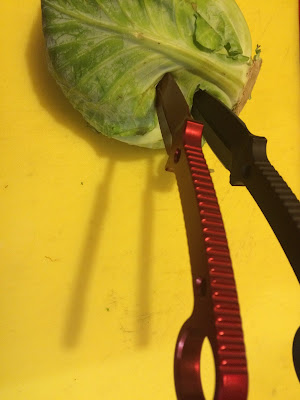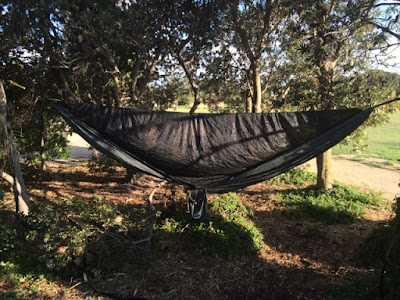First seen on Breach Bang & Clear ....

Here's a follow up from my sneak-peek review of the Propper Range Bag. I took the Range Bag with me on an international trip to the jungle-covered mountains of Bali, Indonesia in mid October for a family event, rather than for a
Tropic Thunder or
Rambo4 themed get-away ... I wanted to maximise my gear-totage, as well as my carry-on capacity. The Range Bag was my upgrade to the very similar
Propper Multipurpose Bag, which I had been using as my every-day bag and as carry-on for some time previously.
The Range Bag is in many respects an up-sized version of the Multipurpose Bag, with many of the same design aspects, such as the long-side opening panels, the double zippered opening top lid as well as it's carry handles and the like.
I decked out my bag with a variety of airport-safe goodies, and needfuls, and set out for international customs and far away vistas. I checked out the 48cm x34cm x 23cm size restrictions on Virgin Australia's international carry-on regulations, and had already confirmed it was good-to go.
Almost twice the width of their Multipurpose Bags, the Range Bag measures 25cm x 38cm x 23cm (10" x 15" x 9") and as I mentioned is a beefed up and expanded version of the MPB. Padded on all sides for increased protection and rigidity, it holds it shape even when empty. There are two stiffened internal dividers, fitted with flaps with hook-field ends to affix the dividers to the fine-finished loop-field covered internal walls of the bag.
These walls can be adjusted or discarded, as fits your use or mission, and the whole of the internal cavity is lined in hi-contrast orange, to help you find your OD tool in its OD sheath in your bottom of your OD bag. I fitted the "back" compartment of my carry-on with a
1L Nalgene bottle, a folded up
First Strike Snatch-Bag ii for any extra incidental bagging I might be needing. In the center compartment I made, I had my novels and iPad for in-flight and hurry-up-and-wait times, I also included my
Propper mesh-sided boo-boo kit, loaded up with all kinds of travel first-aid needs and spares. In the "front" compartment, I had the Propper 5x7 case, which held all our passports and travel documents, and my
Snowgum iPhone case as a batter-backup for my phone.
The main compartment has a lockable zipper, good enough to keep little prying hands away from dangerous things.
On the "right-hand" side panel is fitted with a mesh pocket, and a fold-out mat to do your weapon maintenance or lay out a picnic. The Range Bag also comes with a removable hook-field backed accessory panel. I used that mesh panel to stow PPE gear like my
Barz goggle sunglasses,
earplugs, and other assorted goodies like
Paracetamol and
Ibuprofen. In the folds of the maintenance mat, I included wet-wipes, and a couple of nappies as well, for on-the-go emergencies, as well as acting as very effective blood-sponges. You know, in case of misadventures trying to get a taxi ...

The large end pocket, I filled with a super absorbent travel towel, two hospital grade sick-bags and my
Multicam Headsox . My last international trip involved getting not one, but two lots of little-kid barf on me. Not this time matey! The internal material is also the high-visibility orange, but is off-set by the OD surface material, to make rummaging for items easy, without exposing yourself to unwanted attention by flashes of Blaze. The end pocket had a hook-and-loop patch for securing it, but stuffed full as it was, was not useable. However, the design of the bag kept it all snug and sound. I suspect you could keep a small to medium sized pistol in that pocket, without too much trouble.

The outward facing side panel is covered in a mixture of loop-filed at the top, and two rows of seven channel MOLLE, and inside has another mesh-lined pocket, along with six pistol magazine sized pouches. I stowed personal electronics cables and the like, as well as parkers, crayons (good for both occupying little people as well as waterproof communication and as both kindling and illumination purposes (they make pretty functional candles), as well as an asthma pump. Again, the lockable double zippers allowed me to have a sense of security around both theft and also being reverse-pickpocketed with contraband materials.
Indonesia has a death penalty for drug smuggling.

The front side panel is also fitted out with more MOLLE channels, but I didn't make any use of these. I can see any number of small pouches and carrier working well there though.
One thing I found was that it was very convenient to have the internal compartments, which allowed me to set very specific places for my load. Not misplacing travel documents, (or perhaps a backup pistol, if that's the way you pack) is always a good thing. That said, the extra width of the Range Bag over the Multipurpose Bag meant that it wasn't as easy to rip back the top flap one handed, to get at the insides. the zippers were too fine, and pinched when I tried a few times. Slow and steady wins the race in this case.
It was also pretty comfortable to heft around, the internal padding not only kept my gear safe and secure, but also kept them from jabbing me in the hip and kidneys as I carried it all around.

I also liked that I could pull open the side panels to access the gear I had in there, on the fly, and that it acted as a mobile platform to work from.
Even with a pack on my back, the Range Bag on my hip was able to be swung around and rummaged through with no real problem, and its broad top even acted as an additional platform for carrying more things (or even little people as a bench-seat). The shoulder straps were both just wide enough to spread the load and not too big as to get in the way. The sliding shoulder padding I found was placed in an awkward place, due to the broad tri-glide adjuster, but I managed to feed it into the padding strap eventually. I didn't like the clip-attachment the shoulder strap had though. The broad Fastex buckle from the Multipurpose Bag would have been much better, and enable a one-handed quick-release, in the event I needed to drop and go. With the heavier load of the Range Bag, this would have been even more useful.

I made use of the fold-out mat a couple of times, mostly doing paperwork and the occasional fix-it session, the finish was good and gripping, and not tacky, which is a plus to my mind. I didn't loose and widgets, or little screws so I'll call it a useful addition.
The Range Bag ticked all the boxes for a carry-on bag, as well as a travel accessory. I don't like taking anything I can't carry or sling onto me. I like having my hands free for whatever might come my way, so the Range Bag was a logical step up for when I needed to carry a bit more, or if I needed to carry bulkier, heavier items than I might have otherwise done. Need to carry a bunch of lead to and from your favourite pew-pew place? I have no doubt that your personal needs would be met with this bag. Need to run up and down a hill? Get a ruck.







































